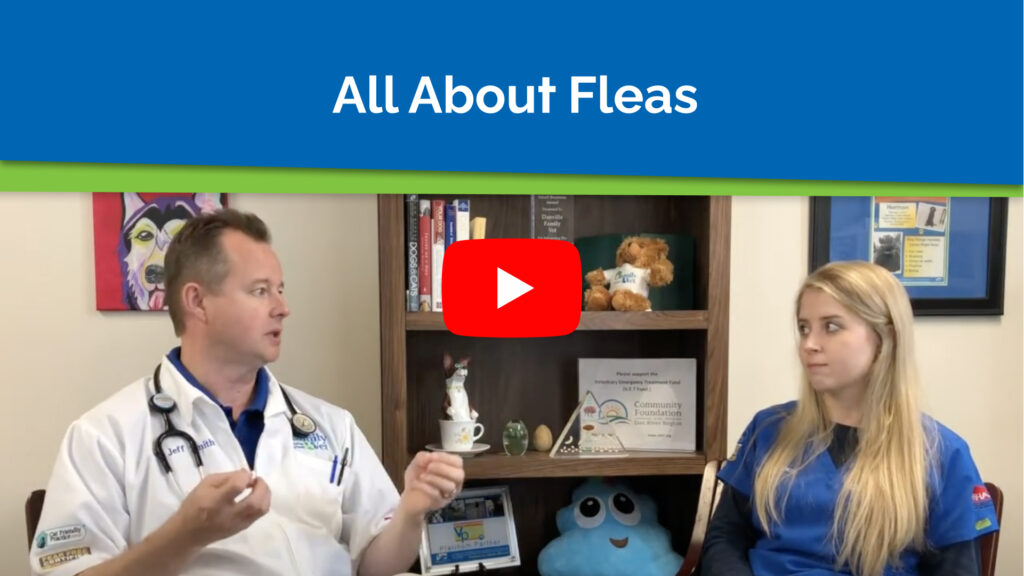The adult flea that is crawling around on your pet is only 5% of its life cycle. Flea eggs can be all around your house and your yard because your dog is walking around and shaking them off everywhere they go. These eggs will then hatch and form larvae, which is a little worm that can crawl deep into your carpet and into the corners of your house. These larvae like to find dark places because that is the best place for them to survive. If they are out in your yard and get hit by the sun they will dry out and die. These larvae will find their way under bushes, decks, sheds, etc. which, coincidentally, is where dogs tend to lay.
The larvae will then go through a pupa stage, which is similar to a cocoon but extremely sticky. The cocoon is able to stick to the fibers of the carpet making it difficult to vacuum up. In this stage, fleas can stay dormant for up to two years, and only come out of their cocoon when they sense animals and humans in the house. They are able to feel vibrations and carbon dioxide in the house and that is when they hatch into a new flea. This process could happen in as little as 30 days or as long as two years.
The trick about a flea problem is that it takes about three months to get ahead of the flea life cycle. You’re treating the fleas on the dog but you aren’t treating the other fleas already in the environment.
How Can You Tell if a Dog is Itchy From Having Fleas or Has a Flea Allergy?
Some dogs can have fleas and when you pull their hair back you see tons of them but the dog isn’t allergic and it’s just a little bit of an annoyance to them. Some dogs can have one flea but they are so allergic that they break out and are very itchy that they chew themselves and pull their hair out. It could be so bad that they cause scabs on their skin from their toenails and teeth. When your pet is being checked, your vet looks at the health of the skin. They don’t just look for bald patches, but if the skin is breaking out or if there are signs of bacterial papules or pustules. This helps determine what type of treatment is needed to stop the itching.
Fleas are tricky because they don’t discriminate and will hop onto any warm body that they come across. This becomes especially difficult if you have multiple dogs or even cats. Fleas love cats and sometimes cats can carry fleas without having any reaction to them. If you or your neighbor have outdoor cats they can accelerate the spread of fleas by carrying them and then laying in the same spot that your dog might lay on later.
The best way to get rid of fleas is by treating the whole environment. Treat inside the house, outside the house, and all the pets that might have been exposed. Because of the life cycle of fleas, it is encouraged to treat the environment again after a month to deal with any new fleas that might have hatched.
Fleas are a frustrating problem to have, but once you get them under control it becomes easier to stay on a year-round preventative. This is the best option because fleas can survive all year in your house. They like the warmth of your house and once they get inside they start laying their eggs and setting up shop. Even in the winter if you have an indoor pet they should still be on flea preventatives.
When it comes to flea preventatives there are a few options you can choose. You can do a topical treatment such as Frontline drops which are very safe and effective. This option requires you to put drops on the back of your dog’s neck once a month. There is also an oral flea control option that works very well and only needs to be taken every three months.
As we mentioned earlier, some cats can have fleas and will have no problems, but some cats can have terrible flea allergies. When a flea takes a bite of the dog or cat, it injects saliva under the skin. The saliva is the antigen that makes them itchy and can last for up to a week after the flea is off your pet. It doesn’t take that many fleas to make your pet itch. Cats will rub their skin raw with the bumps on their tongue when they groom themselves and itch the flea bites. Some cats are very meticulous and will clip their hairs off and it will look like they have been shaved. This usually occurs around the central part of the cat’s belly. When this happens it might be caused by fleas, an allergy, or psychogenic hair loss.
Danville Family Vet is a great source to talk to if you have any questions or issues with fleas on your pet. You can bring in your pet as well so we can take a look at the specific issue and provide our best opinion on which steps to take moving forward.

